In an effort to control the length and size of my original barbell buyers guide, I’ve decided to create a separate guide for powerlifting bars. In this way I can cover a larger variety of bars and offer more information about each individual bar.
If you would like a refresher course on the basics of barbell construction; including rotation mechanisms, sleeve assemblies, finish options, and so forth; refer to the beginning section of my original guide.
Table of Contents
- Power Bars Defined
- What’s Included in this Guide
- Economy Power Bars ≤$250
- Mid-Range Power Bars ≤$500
- Premium/Professional Power Bars >$500
- Fake Power Bars
- Summary
Power Bars Defined
Feel free to skip this section.
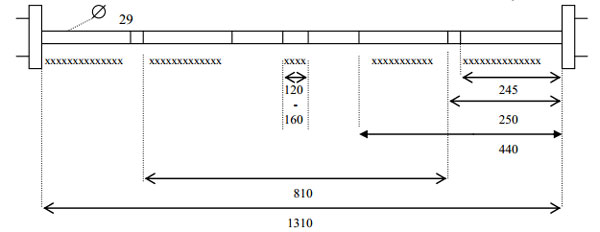
Power bars are intended for the big-3 lifts; the bench press, back squat, and deadlift. Due to the high amounts of weight used in these three lifts, and the fact that no one wants a lot of springiness (whip) in the bar when performing these lifts, power bars are designed to be much more rigid and stiff than Olympic WL bars. This rigidity is achieved by using very high tensile strength steel and larger diameter shafts (29 mm versus 28 mm.)
Power bars are always bushing bars; they have no need for high-spin needle bearings. This is one of the reasons a good power bar is less costly than an equally good Olympic WL bar. Power bars are also more aggressively knurled than the average Olympic bar. They have a center knurl and their own unique set of hash marks (in powerlifting, these marks indicated the maximum legal hand position for the bench press.)
To sum it all up, power bars are thick, rigid bars with little-to-no flex even under the heaviest of loads. They have sharp, aggressive knurling, a center knurl, and bushings for rotation.
Power Bar Guide – What’s Included, What’s Not

I could show anyone deadlifting here, so why not Mark Bell? Dude’s a riot. Check out his YouTube channel. *
In order for a barbell to be included in this guide, it must be a legitimate power bar. It cannot just have ‘power bar’ in its name while having none of the characteristics of an actual power bar. Each bar must also be of a high enough quality that it won’t easily permanently deform, and it should be safe when used with both light and heavy weights.
As is typical of most the guides on this site, my minimum quality standards tend to exclude the cheap, box-store quality barbells. I have however included a single, very low-cost option for those who refuse to spend more cash on their bar than they’d spend on a pair of kicks.
Power Bars <$250
There are not many quality options in the $250 or less category. Matter of fact, there is only one; the bare steel Rogue Ohio Power Bar. If your budget is low and you can’t afford it new, buy it used. If you can’t afford it used, keep saving. If you refuse to buy a Rogue product for some reason, I have listed the only box-store bar that I’d even consider recommending to a friend. You are my friend, right?
CAP OB-86B 20 kg Power Bar
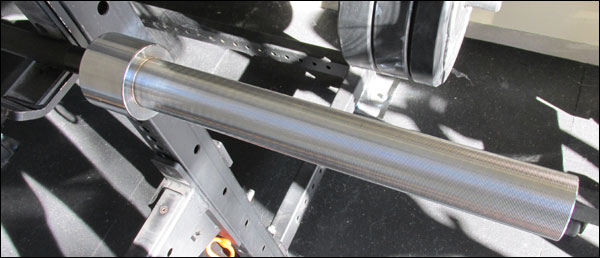
I am not a fan of CAP Barbell products; not one bit. The vast majority of their products are just plain cheap. I also feel the same way about X-Training, Titan, XMark, Weider, and just about any barbell brand that you can buy in a Sears, Wal-Mart, Target, or Dick’s.
That being said, I’ve included in this guide the one cheap barbell that I believe is your best option among all the low-end imports, and that barbell is the CAP OB-86B Olympic Bar. I realize that CAP didn’t name it a power bar, but this bushing-based bar has IPF markings, aggressive knurl, a rigid (although weak) 28.5 mm, 130k PSI shaft, and black oxide finish. Other than having no center knurl, it’s definitely a power bar.
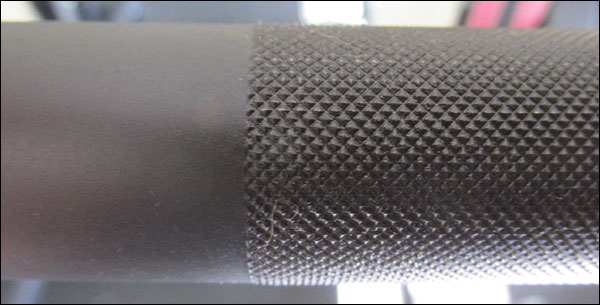
The reason I prefer the CAP OB-86B over the other cheapo bars is because it has a normal shaft diameter, a good, firm knurl with the proper markings, no hex bolts, and it will actually survive a novice strength program. The lack of center knurl is not the biggest of deals in this case because the black oxide finish is super grippy; it sticks to shirts pretty effectively.
20 kg, 28.5 mm, 130k PSI, aggressive, made in China, $139 [review]
Rogue Bare Steel Ohio 45-lb Power Bar
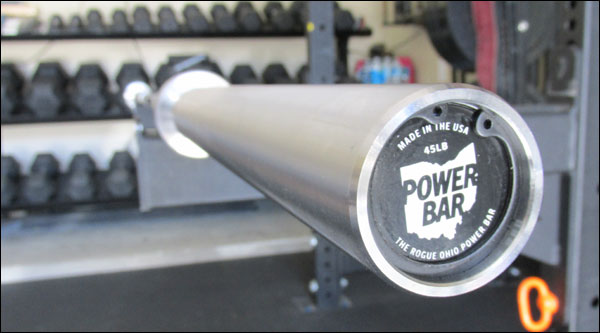
The Rogue Ohio Power Bar is easily the most accessible, high-performance power bar on the market. At only $250 for the bare steel variant, you simply will not find a power bar this well-built for less money.
The Ohio Power Bar is a 45-lb, 29 mm, 205k PSI tensile strength bar with incredible and I dare say perfect [aggressive] knurling. The shaft is incredibly grippy as it is, but the lack of finish makes this bar feel even more secure in the hands; very natural.
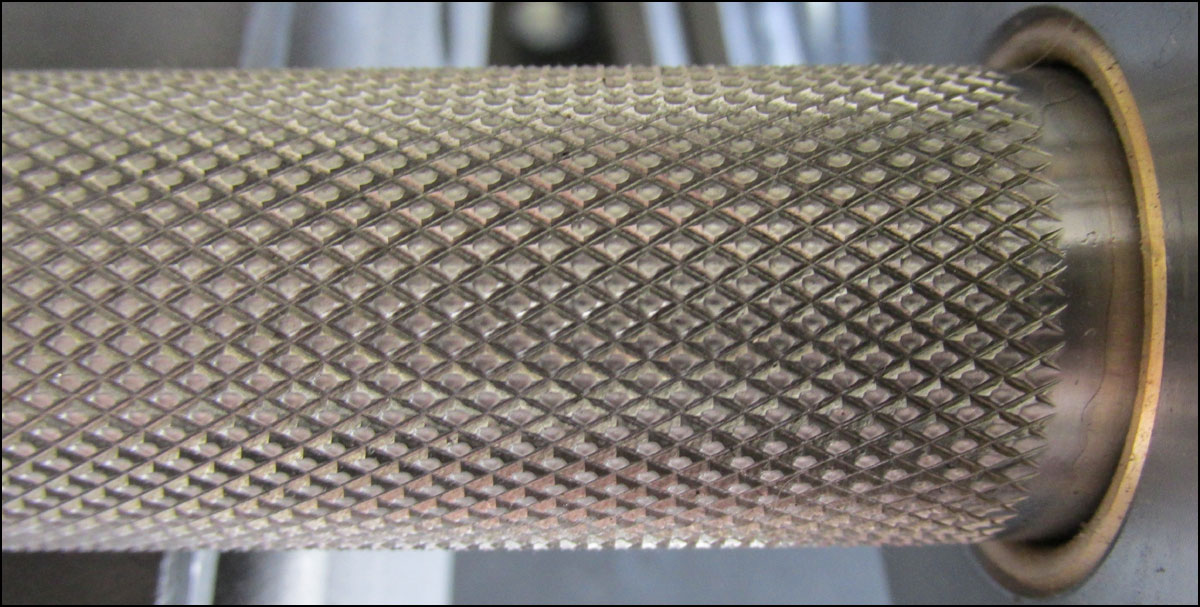
The Ohio is a cast bronze bushing bar – the sleeves spin well enough for a power bar; not too fast, not too slow. It is kind of loud when set down, but unless you are concerned with noise in your gym because of sleeping babies or whiny neighbors, I think it’s a minor thing that’s worth overlooking since everything else is on point.
If your budget is limited and you’re going to go the “economy” route and you’re not wanting a kilogram bar, this is the bar to get. You’ll need to oil and brush it unless you choose the $275 zinc version, but it’s worth it. There is also a 20 kg, zinc-finished version that I’ll cover in the next section.
45 lbs, 29 mm, 205k PSI, aggressive, made in USA, $250 [review]
Mid-Range Power Bars $250-$500
Obviously more feature heavy than the economy bars, these mid-range bars are where the majority of people will find a good match. These will all last a lifetime if cared for. Only very experienced, deep-pocketed athletes should consider venturing into the premium range of power bars in the section following this one.
Buddy Capps Texas Power Bar
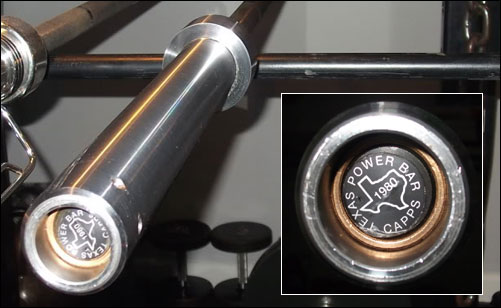
Even after all these years, the 20 kg Buddy Capps Texas Power Bar is still one of the better bar options for lower to mid-range budgets. It features a 186k PSI tensile strength shaft that is 28.5 mm in diameter, aggressively knurled, and finished in a black zinc. The sleeves are raw steel, and they are a tad shorter than average at 15″. The TPB is a bushing bar.

Rarely will you hear anyone speak poorly of the Texas Power Bar. It’s a legendary barbell that still sells for under $300. Now it is true that its shortcomings have been brought more into the light by the introduction of the Ohio Power Bar, but it’s still a solid bar.
What shortcomings? Well the tensile strength rating is actually pretty low by current power bar standards, and the bar’s overall rigidity is not helped by the narrower shaft. Black zinc is also not a very popular finish, and the shorter sleeves have the potential to be problematic if you’re using bumpers. Powerlifters generally don’t use bumper plates, but if you recently transitioned from CrossFit into powerlifting, you may.
I don’t see this as often anymore, but there used to be a problem with companies like Troy using the “Texas” name for power bars when it wasn’t really a Buddy Capps TPB. This led to people buying a bar that they thought was the Capps Texas Power Bar, but really wasn’t. Like I said, don’t see it much anymore, but be aware of it nonetheless.
20 kg, 28.5 mm, 186k PSI, aggressive, made in Texas, $289
American Barbell Power Bar
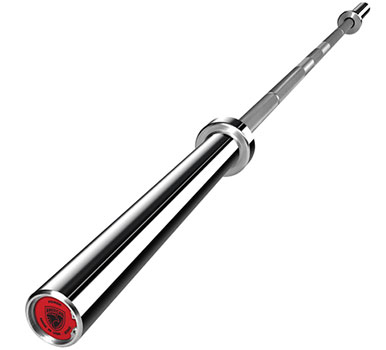
The American Barbell Power Bar is a very reasonably priced, feature-heavy power bar. It’s built around a 190k PSI, precision-grade alloy shaft. That shaft is 29 mm in diameter, has a mild to moderate knurl with center knurling, and standard IPF hash marks. The sleeves spin on industrial composite bushings that are both durable, and reliable under any load.
This bar is unique in that it has a hard chromium finish on both the sleeves and the shaft. I say unique because the overwhelming majority of powerlifting bars are either a raw steel of some sort, black oxide, or in a few cases bright zinc. Chrome is just not a common finish on power bars like we see with Olympic WL bars.
The benefit of raw steel and black oxide bars is simply the feel. Not only is no neutering of the knurl done by applying a heavy finish over it, but the bar just feels much more natural in the hands; rough and grippy. Of course the trade-off for this improved grip is the oxidation, and not everyone wants to deal with the maintenance required to own raw bars or pay the premium for stainless steel. If that’s you, the AB Power Bar is definitely worth considering.
The AB Power Bar is $155 less than the AB Elite Power Bar, and aside from the nicer feel of the Elite’s stainless steel shaft these two bars will perform the same. I believe American Barbell makes some of the nicest bars in the industry; bars that will outlive all of us.
20 kg, 29 mm, 190k PSI, moderate, made in USA, $295
Vulcan Elite Powerlifting Bar
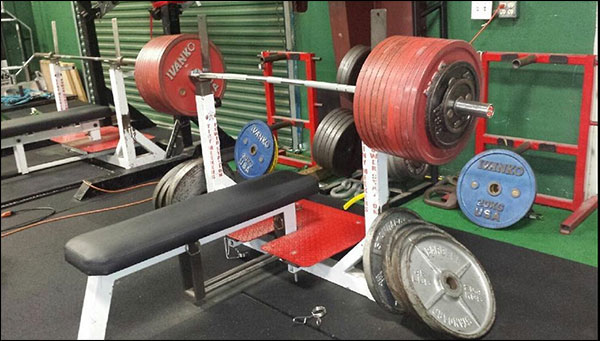
Like the AB Elite Power Bar, The Vulcan Elite Power Bar is another $295, American-made, rust-resistant power bar. It has a 29 mm, 196k PSI shaft that displays almost no elasticity, a bright zinc finish that is much more corrosion resistant than black oxide, and sleeves that spin beautifully on Oilite sintered bronze bushings.
Other than a few points of extra tensile strength, the big difference between the American Barbell Elite and the Vulcan Elite is the knurling; the AB is considered moderate compared to the Vulcan’s aggressiveness. Of course some athletes just prefer a milder knurl, but the Vulcan’t knurl is more akin to powerlifting bars and will probably be the preference for most.
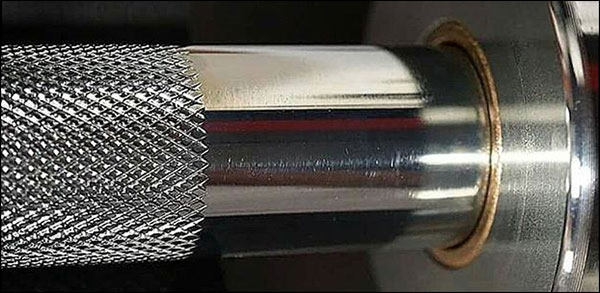
Additionally; and I don’t understand this at all; but the Vulcan Elite is dual-marked. I have no clue why a super rigid, 29 mm bar would have IWF marks, but it does. It doesn’t matter, but it does create a small level of confusion for anyone who picks this bar up not knowing what it is. So it’s not bad, it’s just weird.
Overall this is one hell of a power bar. It’s incredibly rigid, has the premium Oilite bushings, and priced very well for a domestic power bar. Never dismiss Vulcan Strength for barbells.
20 kg, 29 mm, 196k PSI, aggressive, made in USA, $295
Burgener and Rippetoe Barbell
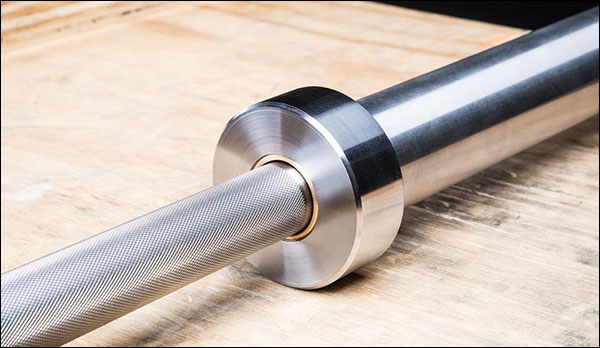
The Burgener and Rippetoe Bar (or B&R Bar) is another dual-marked power bar. Neither Rogue or York (the original manufacturer of this bar) called it a power bar, but it absolutely is and always has been a power bar.
The B&R features a very stiff, 29 mm shaft rated at 205K PSI. It has cast bronze bushings, moderate knurling, a center knurl, and no finish whatsoever. This bar has a very old school feel to it – this is partially due to the specs and mostly because of the raw steel. Despite it not being as aggressive as something like the Ohio Power Bar, the natural feel of the bare steel and the quality of the knurl makes it very easy to grip – very secure in the hands.
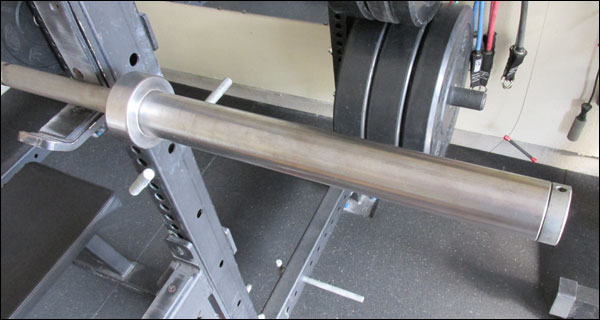
The OG York B&R Bar
I personally liked the sintered bushings and old school end cap of the York variant, but that bar is gone so it matters not. If you can find a used York B&R don’t hesitate to pick it up; it’s a fantastic bar, and one that will last a long damn time. Hell both of them will.
Rogue: 20 kg, 29 mm, 205k PSI, moderate, made in USA, $295
York: 20 kg, 29 mm, 190k PSI, moderate, made in Canada, $295
Rogue KG Ohio Power Bar
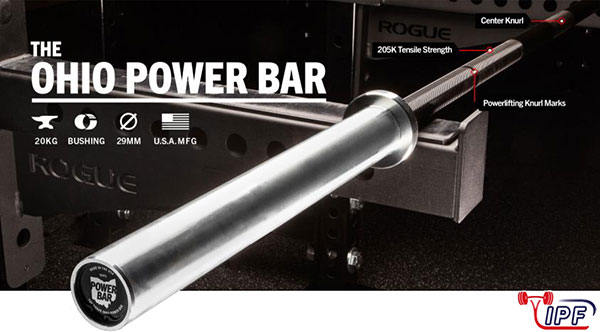
This version of the Rogue Ohio Power Bar is the IPF-approved, kilogram variant. While it uses the same 29 mm, 205k PSI shaft as the standard 45-pound variants, it does have a slightly different sleeve assembly.
Rather than being a single-piece sleeve, the Kilo Ohio has friction welded sleeves. Friction welding is just a fancy and precise way of bonding steel components. I don’t think it has any major impact on life expectancy or anythign like that, but it does provide about an additional ½” of loadable sleeve length over the pound version.
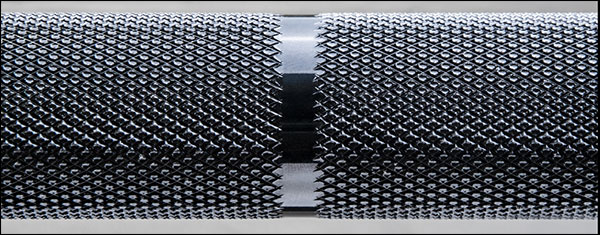
The Rogue Kilogram Ohio Power Bar is offered only in a black zinc shaft/bright zinc sleeve finish. The knurl is still aggressive, the bushings are bronze, and like I mentioned the bar is certified for IPF-sanctioned meets. I personally prefer the price tag on the 45-pound variant, but if you need kilos or you plan to take the bar to a meet, this is the way to go. Also as you probably guessed, this is by far the least expensive IPF-approved bar available.
20 kg, 29 mm, 205k PSI, aggressive, IPF-approved, made in USA, $325 [review]
Westside Power Bar 2.0
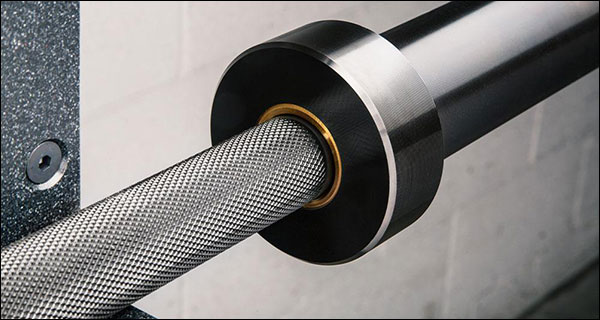
The Westside Power Bar 2.0 is basically the Westside Barbell-branded version of the Ohio Power Bar. It shares all the same specifications as the 45-pound variant; that is same shaft diameter, tensile strength, knurl depth, bronze bushings, and so on. About all that makes it different is the custom end caps the totally blacked-out zinc finish. At $325 I still prefer the standard Ohio Power Bar, but this is a cool way to support Louie Simmons and his gang of elite powerlifters.
45 lbs, 29 mm, 205k PSI, aggressive, made in USA, $325
Vulcan Absolute Powerlifting Bar
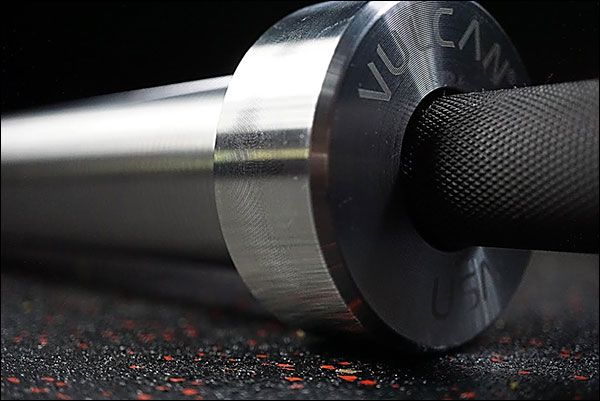
The Vulcan Absolute Power Bar is one of the strongest and most rigid power bars available. At 221k PSI, I think only the $600+ Kabuki Strength Power Bar offers more tensile strength. Obviously the difference between $339 and $600 is worth paying attention to. I’d say that a few hundred bucks easily makes owning just the ‘second strongest power bar’ seem like an okay thing.
The Absolute Power Bar is a legitimate power bar in every sense of the word. It has a black oxide, very aggressive 29 mm shaft, bare steel sleeves, center knurl, and bronze bushings. What makes it stand out from the crowd is its classy, beveled shoulders and laser etched Vulcan USA logo.
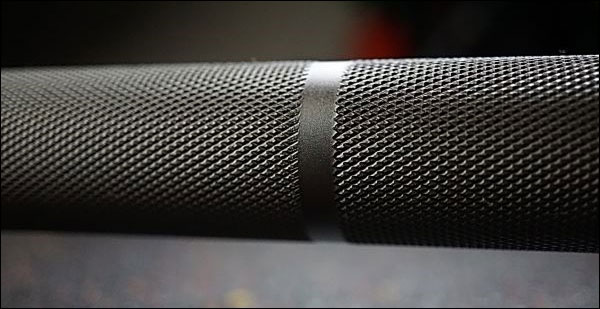
I personally own this power bar and can attest to its feel, rigidity, beauty, and value. Keep in mind though that with a black oxide finish and bare steel sleeves, this bar will require some upkeep ir order to prevent oxidation. Absolutely worth it though.
20 kg, 29 mm, 221k PSI, aggressive, imported, $339 [review]
Troy Power Bar
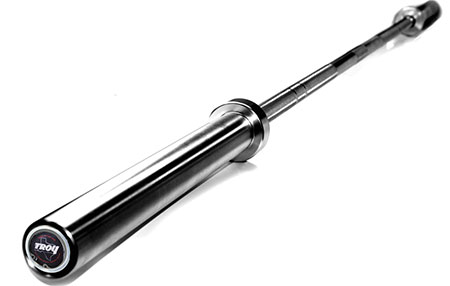
The Troy Power Bar is a power bar, but it’s quite weak in the tensile strength department considering the nearly $360 price tag. At only 177k PSI, it’s the lowest rated barbell on this page save for the Chinese CAP OB-86B that sells for only $139. It also has a 28 mm shaft, which is a peculiar move from a company that’s been making bars for so long.
The Troy Power Bar has an aggressive knurl, a center knurl, and oil-impregnated bronze bushings, It even has a grippy, black oxide shaft finish, but I think this bar is worth ignoring at its current price point. It just doesn’t have enough going for it with bars like the Vulcan Absolute selling for less, and bars like the Texas Power Bar and Ohio Power Bar selling for much, much less.
20 kg, 28 mm, 177k PSI, aggressive, made in USA, $359
York Power Bar #32004
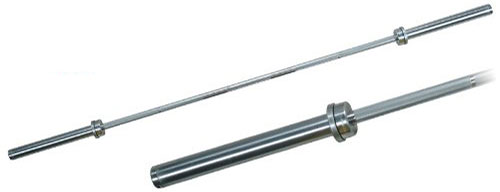
The #32004 York Power Bar is kind of reminiscent of the original B&R bar in terms of both design and specifications. It’s built around a North American (Canadian), 29 mm, 190k PSI steel shaft. It has oil-impregnated bronze bushings, moderate knurl, and the classic bolt-on end cap. Unlike the B&R though, the 32004 is chrome finished, and has York’s famous split sleeve. It also sells for a bit more than the B&R sold for.
It’s not an awful power bar, but it doesn’t really stand out either. The York version of the B&R was not only more affordable, but it was bare steel. Bare steel is just so appropriate for a power bar, whereas chrome may be great for oxidation protection, but it doesn’t feel as good in the hands. It doesn’t matter anyway, this bar is too expensive for the specs.
20 kg, 29 mm, 190k PSI, moderate, made in Canada, $380
Titex Competition Powerlifting Bar
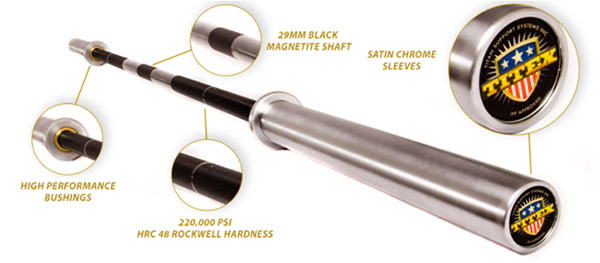
Much like the Rogue Kilo Ohio Power Bar, the Titex Competition Power Bar is yet another reasonably-priced, IPF-approved competition power bar.
For $399, you get a 220k PSI tensile strength shaft (29 mm), sintered bronze bushings, and chrome finished sleeves. Because it’s IPF-approved, it has the center knurl and IPF marks. The finish on the shaft is black magnetite; which I’m pretty sure is just a fancy way of saying black oxide (correct me if I’m wrong); and the knurling is more mild than other IPF bars like the Rogue Ohio.
The Titex Comp is a great choice if you need a certified power bar with milder knurl then the Rogue Ohio, and lower price than the Swedes. The specs are solid and the price is very fair. For training purposes I still think the Ohio Power Bar is a better deal overall, and that $399 price tag really is pushing into stainless territory, and stainless is tough to ignore. The Titex does have chrome sleeves, which is nice.
20 kg, 29 mm, 220k PSI, moderate, made ?, $399
American Barbell Elite Power Bar
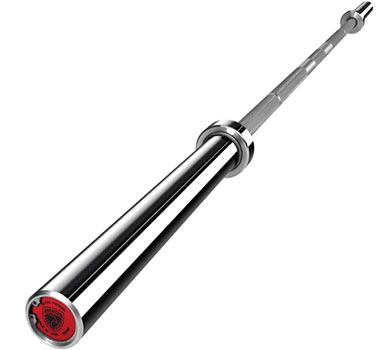
The American Barbell Elite Power Bar is a precision-grade stainless steel power bar. It has a 190k PSI stainless shaft, good rigidity with minimal flex, mild to moderate knurling typical of an AB bar, and hard chrome-plated sleeves that spin on high-load composite bushings. The shaft is 29 mm; it has IPF hash marks, a center knurl, and it’s made in the USA.
The Elite Power Bar is similar to the old AB Super Power Bar. Other than the Super having a 28.5 mm shaft that was heated treated and sort of purplish in appearance, it’s the same bar. Well one other thing makes the Elite different from the Super, and that’s the price tag. The Elite Power Bar is $450 while the Super was $595.
The Elite is a beautiful and functional barbell. It lacks the higher tensile strength of some of the other power bars discussed here, but the fact that it’s stainless steel makes up for that. Truthfully the only disadvantage of the 190k tensile strength versus say a 205k bar is that it will flex more at extreme weights. It’s certainly not that the Elite can’t handle anything you can throw at it.
The AB Elite Power Bar has 23 reviews; 22 of which are 5-star ratings. The 23rd is a 4-star rating that would be 5-star if the reviewer understood sleeve finishes. I’d say that’s a pretty solid track record. This is a very nice power bar.
20 kg, 29 mm, 190k PSI, moderate, made in USA, $450
Premium and/or Professional Power Bars >$500
The following power bars are expensive, premium power bars. With all of these bars you are paying for higher-grade steel (like stainless steel), precision manufacturing, calibration, certification, or all of the above. For all but the most of experienced athletes, these barbells should be considered a luxury; not a necessity.
Excluded from this list are some of the less-common IPF competition powerlifting bars that are not easily accessible in the United States. This includes bars made by Pallini (France), Leoko (Finland), and Zaoba (Japan). Uesaka is also on the IPF-approved list, but even the Uesaka website doesn’t list any power bars. If anyone knows anything about Uesaka power bars, feel free to educate me on their whereabouts in the comments.
American Barbell Mammoth Power Bar
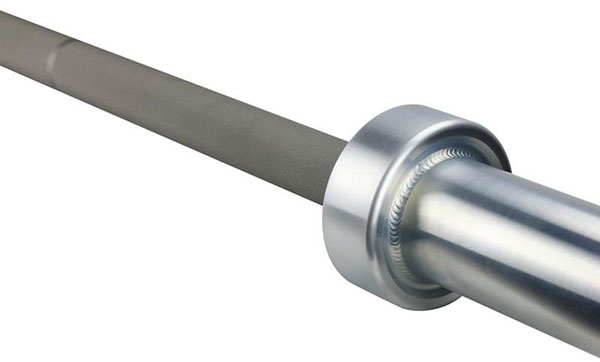
The American Barbell Mammoth Power Bar is the bar that replaced the infamous Super Power Bar; a personal favorite of mine. In a time when your only stainless steel power bar option was a $1200 Ivanko or a $1000 Iron Wolfe, the $600 price tag of the Super Power Bar seemed like a no-brainer. The Super was amazing; it’s a shame that it’s gone.
In any case, we now have the Mammoth. It sports a very rigid 210k PSI stainless steel shaft with a Savage Stainless Cerakote finish. Cerakote offers good grip and corrosion resistance that is more effective than any other applied finish. The shaft is 29 mm in diameter, it has a mild-moderate knurl, a center knurl, and IPF hash marks. The sleeves are two-piece with a unique, recessed weld, and they spin on industrial-grade composite bushings.
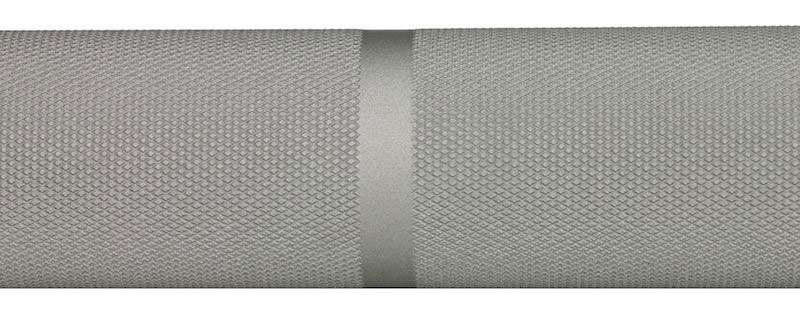
The Mammoth Power Bar is a beautiful piece of equipment. AB’s assembly tolerances are so tight, and you’ll notice this instantly when you pick one up. There is no lateral play in the sleeves and the bars make hardly a peep when dropped. I dare say that no other American barbell manufacturer makes a nicer, quieter, or more precise barbell.
Unfortunately, where the Super Power Bar was all pros and no cons, the Mammoth Bar has a con, and it has everything to do with the price. American Barbell took the most expensive shaft material available; stainless steel – with its perfect grip and great corrosion resistance; then applied a finish to it. Now as good as Cerakote may be, in my personal opinion it still falls short of stainless.
With the Mammoth Bar you pay for both the stainless steel and the Cerakote finish, but you don’t get any benefit from the stainless (the more expensive of the two) save for some extra oxidation resistance IF you blow through the Cerakote finish somehow. I’m of the opinion that the Mammoth should have been alloy steel if it was going to have that Cerakote finish, as the bar would cost closer to $400 rather than the $550 it currently sells for.
Truth be told, I absolutely love American Barbell. I think the Mammoth is an incredible bar, I just think that it’s far too costly being that you’ll be gripping the Cerakote and not stainless steel. Fortunately, AB offers the Elite Power Bar which is unfinished stainless steel. It’s not the same 210k shaft, but it is a 29 mm power bar that is almost exactly like the old Super Power Bar only without the heat-treated, purplish steel. The Elite is $100 less than the new Mammoth, and $150 less than what the Super sold for.
Mammoth: stainless/Cerakote, 20 kg, 29 mm, 210k PSI, moderate, made in USA, $550
Super: heat-treated stainless, 20 kg, 28.5 mm, 190k PSI, moderate, made in USA, $595
Kabuki Strength New Gen Power Bar

By all accounts, the new Kabuki Strength Power Bar is going to be a beast of a bar. It’s not currently released at the time of this writing, but it looks like it will be retailing for about $600 to $700 depending on the finish. Finish options will include zinc, black oxide, and nickel.
The Kabuki Power Bar is a 20 kg, 29 mm power bar with firm, aggressive knurling typical of power bars. It has a tensile strength is excess of 250,000 PSI, a center knurl, and bushings of an unknown type; I assume bronze. This bar is made in the USA and is no doubt a solid bar, but the price is quite high. We’ll see soon enough.
20 kg, 29 mm, 250k PSI, aggressive, made in USA, $600+
Eleiko Performance Powerlifting Bar NxG
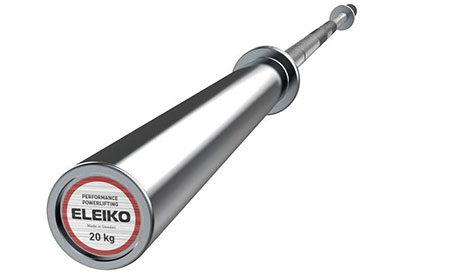
The NxG Performance Powerlifting Bar is just a new name for the classic Training Powerlifting Bar. The name changed, but none of the specifications changed. It’s still a 29 mm, 20 kg power bar built around a 215k PSI Swedish steel shaft. This bar has very aggressive knurl, a center knurl, bronze bushings, and a galvanized zinc finish. This bar adheres to all IPF specifications.
20 kg, 29 mm, 215k PSI, very aggressive, made in Sweden, $849
Ivanko OBXS-20KG Powerlifting Bar
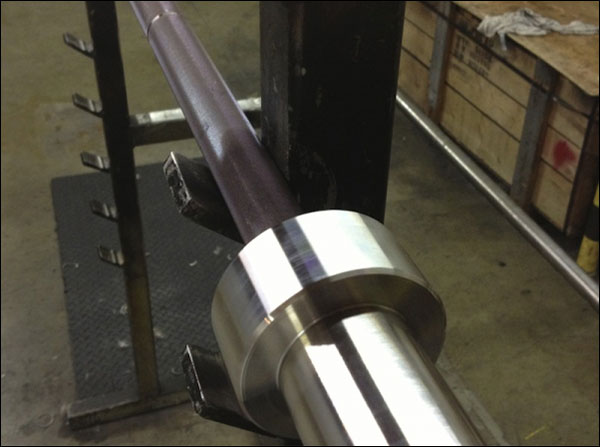
The Ivanko OBXS-20KG is another stainless steel power bar; a very expensive one at that. Part of what makes Ivanko bars so expensive is that they put each and every bar through a number of tests before shipping them out. They go through a mag test, an ultra-sonic test, and a straigthness test. They do this to ensure that each barbell leaves the factory without a single imperfection.
The Ivanko OBXS adheres to all IPF specifications. The 218,000 PSI stainless steel shaft is aggressively knurled and then left unpolished as to not take the edge off that knurl. It’s a very aggressive bar, and it has a very unique blueish/purplish color to it because of how it’s worked and left unfinished. Beautiful, but extremely expensive.
20 kg, 29 mm, 218k PSI, very aggressive, made in USA, $1259
Fake Power Bars
At the start of this article I discussed what makes a power bar a power bar. It’s important to note that there are a lot of bars out there that are called power bars, but really are not. This means that unless you are paying attention to those product specs, you may end up buying a bar that won’t meet your needs. Here are some things to look for:
- power bars should have bronze or composite bushings, not needle bearings.
- power bars should have IPF hash marks, not IWF.
- power bars should have a center knurl.
- power bars should be 29 mm in diameter; 28.5 in rare cases.
- power bars should have fairly aggressive knurling.
- power bars should have at the very least a 190k PSI shaft.
- No power bar description should have the words “snatch” or “jerk” in it.
In some very rare cases, one of these specs may be off. Like the Vulcan Elite is very much a power bar, but it has dual-marks; or the American Barbell bars tend to have milder knurl, but are in every other way legitimate power bars. But if you stumble across a 28 mm bar with no center knurl or a 165k PSI bar with a 32 mm shaft, move on. I mean you’re free to buy it, but it’s not a power bar.
Power Bar Guide – Summary
I’d love to give some recommendations, but so much of selecting a power bar comes down to personal preference; mostly the finish/feel, and the aggressiveness of the knurl. Then of course your options are dictated by your budget. I will say though that for the typical budget of say a few hundred bucks, the Vulcan Absolute really stands out. It’s incredibly strong and stiff, has a solid knurl, and an extremely grippy black oxide finish. The laser etched sleeves are a nice touch too.
For lower budgets I think the Rogue Ohio Power Bar in bare steel is the obvious choice. It’s just so much bar for the money. High tensile strength, great knurl and feel. Like I said in the beginning, if you can’t afford it new, I’ll bet you can find it used. Trying to get much cheaper than the cost of this bar is probably a mistake in the long term.
My least favorite bars in this guide are the York and Troy because of features vs price, the CAP because it’s just not a very good bar in general, and the Ivanko; which I believe is just ridiculously overpriced considering the availability and price of other power bars.
It’s possible I’ve overlooked a bar or two. Did I leave your favorite power bar out? Leave a comment and let me know. I also appreciate those shares.
* image no doubt belongs to Mark Bell. Just trying to show some love – I will remove upon request.

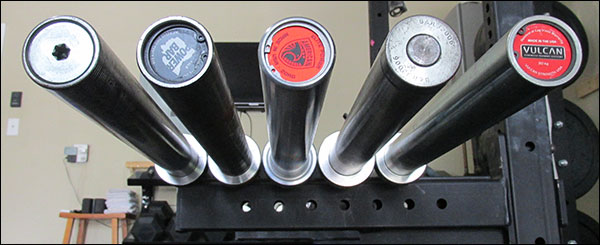
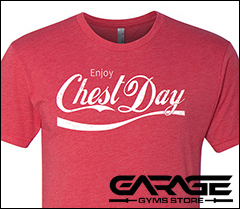
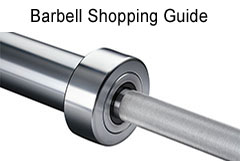
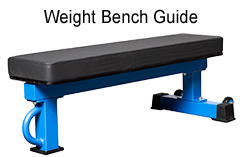
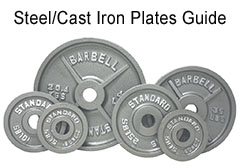
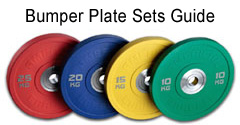
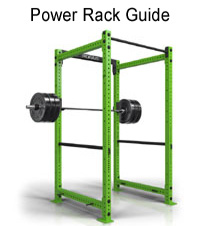
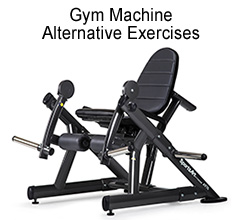

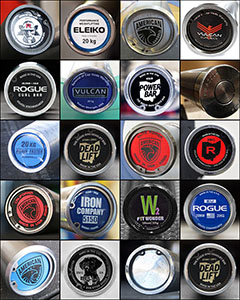

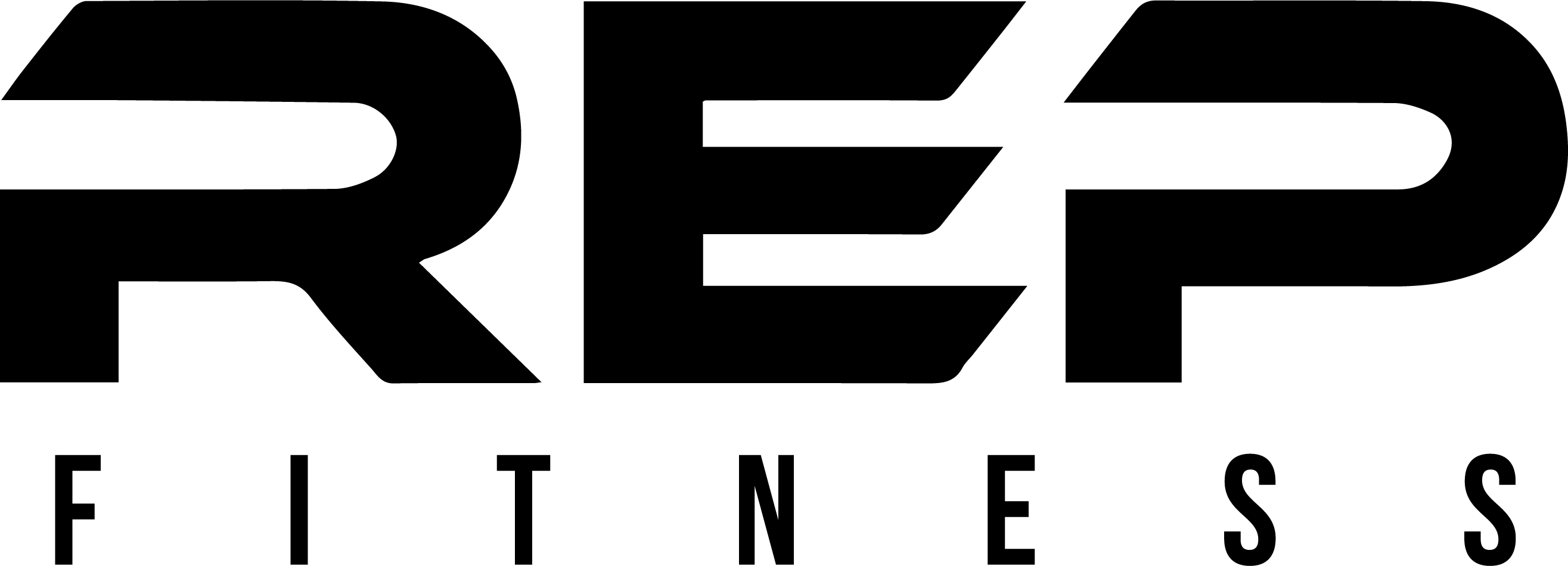
Bought the Vulcan Absolute based on your review. It is a wonderful bar!! Stiff, Aggressive knurling which I love, and a center knurl aggressive enough to stick the bar to your back.
That thing has glue on it, Shane. Black oxide is fantastic. Buy some oil and some rags though. Keep it clean.
This list is not complete. You have to mention Leoko, IPF approved powerlifting bar from Finland. In Europe it goes for roughly 550 Euro including shipping to all of EU.
Indeed, but the inclusion of Leoko is meaningless as there is nothing to say about them other than that they exist. What would I put in the description? The US market is mostly unaware of this company, there are no specs to share, and most of the world can’t buy one even if they wanted one. Leoko hasn’t updated their own website in what? 10 years? It was a pointless bar to include really. But yes, I am aware of their existence and if I had access to Leoko, I’d own one if for no other reason than I am a Nordic nerd.
Also let’s be fair, this list could never technically be “complete.”
True.
215000 psi, knurling more rough than eleikos power bar – it does remind me of the Ohio power bar knurling. Sold in all black oxide, or black zinc coating w chrome sleeves. It is possible to order a raw bar with just chromed sleeves. The barbell has not really changed since the late 70s. The bar becomes overly expensive when shipped beyond the EU/Russia zone – especially when you guys have the OHP, which is also IPF Approved. I own a Leoko barbell and like it more than the Eleiko at my local gym – should I buy a power bar today I would opt for the Leoko again – maybe – The price and quality of the OHP 20kg is difficult to ignore.
So what’s their story? Why don’t they expand? Or even try to expand. It’s obviously not a dying market.
I honestly don´t know. I wrote to Leoko a few months back regarding a former purchase but I also made an inquiry into why they didn´t push their barbells harder. I didn´t get a straight answer – but I got the feeling that perhaps they felt that their marketshare was big enough – I know that it is an extremely popular barbell in at least parts of western Russia as I have travelled there extensively.
Good stuff. Any idea when you will be reviewing the Kabuki power bar?
I haven’t decided if I will or not. At $640-$730 shipped, I’d need to know there was a genuine interest in the product, otherwise it’s a very expensive review that only three people would read.
Honestly most super premium bar reviews get no attention. They are very low performing articles. I mean I don’t have AdWords or anything so I don’t care about page traffic in that sense, but what that low performance tells me is that interest in the highest end barbells just isn’t there – in reality. That is, everyone would love to have an Eleiko Oly Bar or Kabuki Power Bar, but very few people would ever actually spend their own money on these products.
Still, I like reviewing that stuff even if it’s at a loss, but I do need there to be some interest at least, and so far there really hasn’t been. It’s on my radar though, and if Kabuki asked for a review I’d obviously do it, but they won’t lol.
I might have to save up. Vulcan Absolute in stainless is on pre-order now.
Oh ya look at that. I heard a rumor about that one, glad to see it’s coming out.
So I see that American Barbell has milder knurling than a typical power bar. How would you compare the knurling to Rogue’s general purpose bars (Ohio Bar) or the B&R Bar?
I’m currently planning on getting the B&R Bar a la Starting Strength since most power bars would have too aggressive of a center knurl for power cleans. I’m trying to determine if the Grizzly Bar from American Barbell is worth the savings since it’s a lower price-point and has less maintenance needs because of the chrome finish.
I think it’s equally good of an option for Starting Strength and priced appropriately; if not quite reasonably. Bare steel does require the maintenance, but it has its advantages for those willing to deal with that. If not, the Grizzly is perfectly viable option.
Would you say any of Vulcan’s power bars have a mild/passive enough knurl for power cleans?
I think the black oxide Absolute I just reviewed is mild enough, but it’s not “passive”. Did you see that review? I just published it yesterday. It has pictures of the outer and center knurl in it.
Awesome. I’ll check it out. Haven’t checked my RSS feeds yet so I didn’t get a chance to read it yet. I’ll definitely do that now. Thanks!
I’m debating between the Rogue Ohio Power Bar, The AB Grizzly, and the AB Power bar closeout, they are all $250.00 but my concern is that if I go with the AB the knurling I wouldn’t like however I’ve never really handled a good bar so I wouldn’t know lol if I go with the AB could chalk help grip the bar? ahhhhh I hate making decisions like this!!!!
American Barbell knurl is consistent from bar to bar, and while it’s milder than the Rogue bars it’s still a better knurl than the average gym bar – like the crap you’d use in a Gold’s or 24Hour. Chalk always helps, but honestly it’s not going to be too mild unless you’d deadlifting a ton of weight – doesn’t even matter on the bench or squats. Only those who truly prefer an aggro knurl would take issue with an AB bar I think.
So as far as the two AB bars the power and the grizzly, because they have the power bar for 250 on their like boneyard bars which would be the same price as the grizzly, the only thing is that there is no warranty on the closeout item. I plan on in the future when I get more weight on the bar to get a new one, its just my budget won’t allow it
There’s no real reason to want the closeout over the Grizzly. The Grizzly is a perfectly good power bar. Technically they are the same bar in terms of specifications, and warranty is a warranty. Either way, these aren’t bar that you’d need to be in any hurry to upgrade. AB bars will last a lifetime. That’s not to say that you couldn’t upgrade because you wanted to, you just aren’t ever going to destroy it short of being negligent.
You mentioned they’re quiet barbells as well that company, have you handle the grizzly?
No not yet, but I’ve handled most of their line – even own five or six of their bars right now. They’re very consistent, and yes they are very quiet compared to everyone else.
I saw a review that because of the knurl it hard to get grip even with chalk do you find that problem or is it more of a feeling as far as grip on the bar?
when you say a ton of weight lol what do you mean?
(I currently am doing the starting strength program)
Sorry I hadn’t seen this one Isaac.
Like 500+ lbs. I’ve deadlifted with a lot of American Barbell bars in the process of reviewing them. Chalk goes a long way on any bar when pulling a lot of weight, and the same is true with AB bars. In all fairness though, when I’m lifting at 90%+ on deadlift and I’m not reviewing a bar, I use straps anyway.
Where did you see that review? Was it a professional review or just a user-left review?
I’ve noticed that you mention the tensile strength effects the flex in the bar. This isn’t true the flex has to do with young’s modulus of elasticity and is almost identical for all steel alloys so the only thing that effects a bars flex is the diameter and distance between collars.
Yeah I’ve had to address this a couple times because of that Hook Grip video. I absolutely disagree that bars of like-diameter all display the same elasticity. Tensile ratings and yield ratings; not to mention the material used; all impact rigidity/flex to varying degrees (as does the distance of the plates from center as you mentioned – though that rarely, if ever, changes among bars).
I challenge anyone to prove me wrong though. A simple link to something that explains in English why alloy A and alloy B at the same diameter/length will have the same flex despite having different properties. So far nothing.
The thing is the Young’s modulous is literally the ratio of stress to strain in tension. It’s a material property that directly quantifies the elasticity (flexibility) of a material. It isn’t going to be the same for all steel, steels with different tensile strength will most likely have a different Young’s modulous. A really big factor will be hardness. A harder more brittle steel will not have as much flex and will have a yield strength closer to its tensile strength. I don’t think there’s anything wrong with comparing the bars by tensile strength. Now if manufacturers would take a sample of steel after work hardening or heat treating as it would be used in their bar and tested its Young’s modulous and published that along with their tensile strength that would be useful as it would allow you to directly compare flexibility between bars more accurately.
Most manufacturers won’t even publish the yield let alone give us any details on specific materials used beyond just “steel” or “stainless steel” etc, or the results of any internal testing (unless they are favorable 100% of the time).
Even if we knew the yield and/or the specific formulas of steel used in any given bar, who would even know what to do with that information? People would still be reading reviews to see how a bar actually felt in the hands; how it was received by other lifters, because at the end of the day anyone who has lifted on multiple bars knows that they don’t all feel and flex the same.
Nice reviews. Just my experience on the Texas Power bar vs. Ohio Power bar in zinc, after having 3 of each in my commercial gym for the past 4 years. The Ohio bar looks great when new, but the finish on the shaft wears off relatively quickly and unevenly. The finish on the Texas bar holds up much better. We also occasionally have a bar dropped in the rack, and the Texas bars have taken the beating much better. One of our Texas bars has a very slight bend and the other two remain perfectly straight, while all three Ohio bars are bent. The higher rated PSI of the Ohio bar hasn’t translated to real life performance in my experience.
Thanks for that. That’s good to know.
It’s entirely possible that Buddy has a better tensile to yield ratio than Rogue. Neither of them disclose their bar’s yield ratings, so who knows. Three bent OPBs and one bent TPB is telling, but it’s almost hard to make a call on that because rack pulls can ruin any bar. I concede your point on the finishes though. I’m not a fan of Rogue’s zinc. I think it’s a weak finish.
Fair points. Not only have the Rogue bars bent more frequently, but they’ve bent to a greater degree. Not trying to bash Rogue, as their products are generally very solid. I agree that rack pulls done carelessly are a bar killer… for any gym owners out there I’d recommend designating a specific bar for rack pulls and just plan on it eventually getting trashed. A TPB would be a good choice for its price and durability.
I bought my Rogue bare steel Ohio Power bar as a boneyard purchase on their web site. These bars have minor manufacturing blemishes but they sell them at a deep discount. When I opened my bar I had to look very hard to find the flaw. The knurl track started a little off center before the machine corrected and finished the knurl. It was purely cosmetic. I paid less than $200 and would buy another without hesitation. Currently waiting for a bone yard dead lift bar to get listed.
Yeah, you can really win in the Boneyard.
What is your opinion of the new Rep Power Bar Ex for a novice? I know it partially comes down to preference but is the knurling too aggressive for a noob to handle? Their standard knurl SS power bar is out of stock but also at the exact same price (feel like I’d potentially miss out on better features).
I don’t think it’s too aggressive. It’s actually a really nice knurl. I just took it out of the shipping tube yesterday and I was quite surprised by it. I’m going to actually lift on it today and get a better feel for how sharp it feels bearing down on the palms.
I didn’t know most of this bar info even though I own four old bars. My eyes are open to bar facts now. Thank you very much.
How does the knurl of the AB Elite Bar compare to the following bars for sub 500lbs through Starting strength; B&R 2.0, Starting Strength – BCapps, Chan – SS Cerakote? Also, I have a boneyard deadlift bar so am good in that respect. Thanks for your thoughts and your website!
The Elite, and all American Barbell bars, have a very moderate knurl that has no coarseness or aggressiveness to it, though it’s still a very refined knurl with a solid amount of grip. The B&R is probably the closest thing to an AB bar in terms of knurl aggressiveness, with the Chan and Capps SS Bar being slightly more aggressive (but not a lot.) Not needing an American Barbell power bar for deadlifts makes it probably the best power bar option in the stainless steel arena. Deadlifts are probably the only lift where you’d be questioning the knurl depth.
Thanks for all the great information – we live in a terrific age for availability of homeowner lifting gear and knowledge such as yourself! Have a great weekend.
Thank you for your help and patience. Sorry for the duplication of questions on my part – I should have dug around your site a little more thoroughly before posting similar questions on multiple articles.
REQUEST FOR STAINLESS STEEL BARBELL PURCHASE RECOMMENDATIONS:
I greatly enjoy your reviews and find them and comments made by your readers very helpful and insightful. I am currently considering purchase of a stainless steel barbell for use doing the bench press and seated presses with my steel plates. Two possibilities are the Rogue Pyrros olympic bar and the newly introduced Rogue full stainless (bar & sleeve) Ohio Power Bar. History relevant to my question is this: I am in my mid-60’s and have been religiously lifting (multiple world, national, and state records in the bench press during my 30’s) using the same well cared for York power bar and York steel plates since I was 16. In coastal Florida, corrosion has become a problem with the bar and I am increasingly considering purchasing one (or both!) of the above bars. I no longer compete and my interests are mainly to maintain my physique. Also, I no longer bench anything over 180-200 lbs due to shoulder cuff injuries. I never do any olympic lifts, no squats, no deadlifts——— just bench press, shoulder presses, and a fair amount of dumbbell work. I just took delivery of my Rep Fitness fully stainless EZ curl bar yesterday.
Cost is not much of an issue. When possible, I prefer to avoid Chinese products (e.g. Rep Fitness, Vulcan, and Ivanko). Eleiko apparently doesn’t make a fully stainless bar. I would purchase the American Barbell with their race needle bearing system if they produced bars with fully stainless bar AND sleeve. Since that is not the case, I am intrigued by the needle bushings used in the Rogue Pyrros and wonder if the flex/whip of the Pyrros olympic bar would be an issue doing my multiple repetition lower weight bench presses.
Your thoughts? Thank you for any comments you and your readers would be kind enough to make!
I wouldn’t normally recommend a weightlifting bar like the Pyrros for pressing. The cost is prohibitive when you consider that you’re paying for features that only benefit the Olympic lifts; like the whippy, 28 mm shaft and needle bearings. That said, what you’re putting on the bar isn’t going cause any real flex in the shaft with such slow movements, and it’s not unheard of for people to actually prefer a narrower shaft (28 vs 29) even for the big three. There’s certainly no reason you couldn’t press an Oly bar, and if the more, moderately-aggressive knurl of the Pyrros seems more appealing to you than the razor sharp knurl of an Ohio Power Bar, then by all means go for it – especially since, as you say, cost isn’t really a contributing factor.
Also, since you do prefer an American-made bar AND you want fully stainless, well there isn’t much else to even recommend outside of the American Barbell bars (which by the way, those sleeves have such a thick layer of industrial chrome that it’s pretty unlikely you’d ever find even a hint of rust. Also, tiny metal shards from your iron plates will rub off on your stainless steel sleeves and cause surface rust eventually, even on stainless. Now it is surface rust and is easily removed, but just so you’re not looking at that and going “well what the hell, this isn’t supposed to oxidize.” It’s not, or won’t, if you don’t let it sit there. I hope that made sense haha
Gradually I’m working my way through all of your different pages of recommendations ;)
On the Eleiko bar reviewed above (since that’s the only regular power bar that appears to be in stock in the UK currently), I notice you say it has a steel shaft with a galvanised zinc finish, but I don’t see galvanised zinc in your list of finishes on the main barbell page. Where would this fit in along that scale?
Galvanized is dipped, standard bright zinc is electroplated. Galvanized is thicker and more resilient; generally meant for outdoor use, while the standard zinc finishes for barbells tend to be more aesthetically pleasing and less protective (in terms of longevity, anyway.)
I recently purchased a Buddy Capps Texas Power Bar. I know this review was written several years ago. However, Maybe a re-review of the New Texas Power Bar. I believe its been updated to better compare to todays market. They have increased the Tensile strength to 190k minimum and added Cerakote finishes to the Bar which is extremely important for me because I live in Florida and I just cant maintain a bare steel bar here it’ll flash rust daily in this humidity. However, with that being said the price has increased slightly with the added finish. Do you think these small upgrades would make you consider a TPB over a OPB?
This absolutely does need a revision, you are right.
I think the TPB is a great alternative to the OPB as well, and I don’t think either of these bars are improperly or unreasonably priced.
The Texas Deadlift Bar also received these updates, and I now favor (and use) one over the Rogue Deadlift Bar.